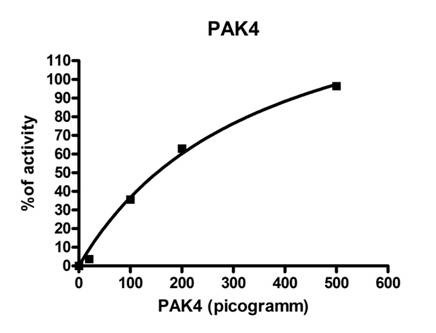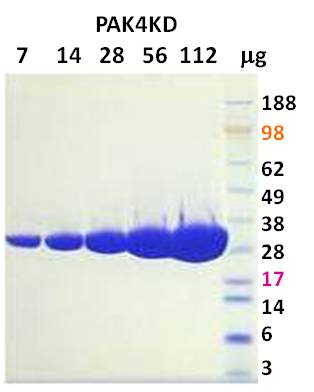PAK4KD (recombinant human PAK4 kinase domain)
본문
PAK4KD (recombinant human PAK4 kinase domain)
A. Product detail
1. Description :
Human PAK4 kinase (UniProt: O96013; NCBI: NM_005884) belongs to a family of p21-activated kinases. These serinethreonine kinases are regulated by the small GTP binding proteins Cdc42 and Rac and have been implicated in a wide
Human PAK4 kinase (UniProt: O96013; NCBI: NM_005884) belongs to a family of p21-activated kinases. These serinethreonine kinases are regulated by the small GTP binding proteins Cdc42 and Rac and have been implicated in a wide
range of biological activities. PAK4 is a mediator of filopodia formation and may play a role in the reorganization of the
actin cytoskeleton.
PAK4KD is a recombinant wild type human PAK4 kinase domain (amino acids 300–591 of full-length human PAK4)expressed in E. coli and purified to homogeneity with full activity.
PAK4KD is a recombinant wild type human PAK4 kinase domain (amino acids 300–591 of full-length human PAK4)expressed in E. coli and purified to homogeneity with full activity.
2. Molecular Mass and Phosphorylation :
The calculated mass is 33,309. PAK4KD is fully phosphorylated at S474 with a measured mass of 33,389 (1P).
The calculated mass is 33,309. PAK4KD is fully phosphorylated at S474 with a measured mass of 33,389 (1P).
3. Applications :
Enzymatic studies, inhibitor screen, and selectivity profiling
High concentration available for crystallization
Enzymatic studies, inhibitor screen, and selectivity profiling
High concentration available for crystallization
4. Stability and Storage :
Stable at -70°C for 12 months from date of receipt. Protein should be thawed on ice. Protein can be flash-frozen in liquid nitrogen and stored at -70°C.
Stable at -70°C for 12 months from date of receipt. Protein should be thawed on ice. Protein can be flash-frozen in liquid nitrogen and stored at -70°C.
B. Data sheet
1. Sequence :
GPHMSHEQFRAALQLVVDPGDPRSYLDNFIKIGEGSTGIVCIATVRSSGKLVAVKKMDLRKQQRRELLFNEVVIMRD
YQHENVVEMYNSYLVGDELWVVMEFLEGGALTDIVTHTRMNEEQIAAVCLAVLQALSVLHAQGVIHRDIKSDSILLT
HDGRVKLSDFGFCAQVSKEVPRRKSLVGTPYWMAPELISRLPYGPEVDIWSLGIMVIEMVDGEPPYFNEPPLKAMKM
IRDNLPPRLKNLHKVSPSLKGFLDRLLVRDPAQRATAAELLKHPFLAKAGPPASIVPLMRQNRT
GPHMSHEQFRAALQLVVDPGDPRSYLDNFIKIGEGSTGIVCIATVRSSGKLVAVKKMDLRKQQRRELLFNEVVIMRD
YQHENVVEMYNSYLVGDELWVVMEFLEGGALTDIVTHTRMNEEQIAAVCLAVLQALSVLHAQGVIHRDIKSDSILLT
HDGRVKLSDFGFCAQVSKEVPRRKSLVGTPYWMAPELISRLPYGPEVDIWSLGIMVIEMVDGEPPYFNEPPLKAMKM
IRDNLPPRLKNLHKVSPSLKGFLDRLLVRDPAQRATAAELLKHPFLAKAGPPASIVPLMRQNRT
- The first 4 residues GPHP are from Turbo3C cleavage site.
- Phosphorylated at S474.
- Phosphorylated at S474.
2. Component and Formulation :
PAK4KD: 1 mg/ml in Storage Buffer of 25 mM Tris-HCl pH8.0, 150 mM NaCl, 10% glycerol, 5 mM DTT.
PAK4KD: 1 mg/ml in Storage Buffer of 25 mM Tris-HCl pH8.0, 150 mM NaCl, 10% glycerol, 5 mM DTT.
3. Specific activity :
Specific activity: 5,595 pmoles/min/µg
Specific activity: 5,595 pmoles/min/µg

Analysis of enzymatic activity was performed according to Zlyte assay protocol (Invitrogen) :
- Different concentration of PAK4KD were incubated in a buffer containing 50 mM HEPES (pH7.5), 10 mM MgCl2, 1 mM EGTA, 200 mM ATP, 0.01% Brij-35, and 2 µM substrate (SER/THR 14, Invitrogen) at room temperature for 1 hour.
- Developer solution was added to reaction and reaction was stopped after 1h of incubation at RT.
- Fluorescence was detected using λexc=460±40 nm and λem=528±20 nm filters.
4. SDS-PAGE Analysis :

Ordering information ;
1. 10 µg
2. 100 µg
3. 1 mg
4. Bulk 단위로도 공급이 가능합니다.(별도로 문의 바랍니다)
2. 100 µg
3. 1 mg
4. Bulk 단위로도 공급이 가능합니다.(별도로 문의 바랍니다)
* Concentration : 1 mg/ml
댓글목록
등록된 댓글이 없습니다.